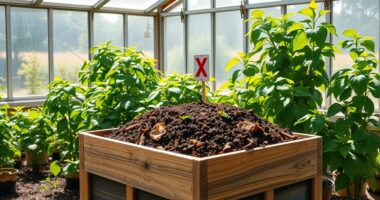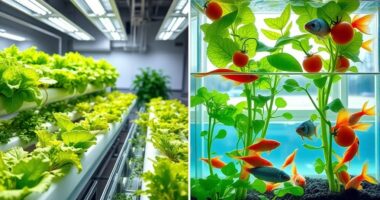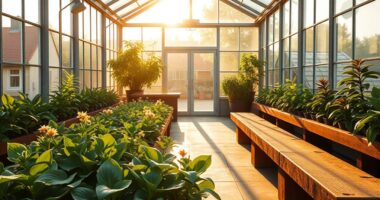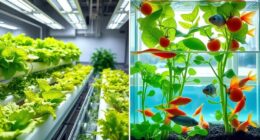Building a greenhouse with recycled materials is a great way to stay eco-friendly and save money. You can use recycled plastics like polycarbonate sheets for glazing or PET bottles for irrigation systems, ensuring they’re durable and UV-resistant. Wooden pallets and reclaimed lumber make good framing options, but always check for rot or damage. Reinforcing weak spots and inspecting materials helps create a sturdy, long-lasting structure. Keep exploring to discover more tips for successful green building.
Key Takeaways
- Select durable, environmentally resistant recycled materials like UV-stabilized plastics and treated wood suitable for greenhouse conditions.
- Thoroughly inspect and reinforce recycled components to ensure structural integrity and longevity.
- Prioritize materials that are easy to clean, non-toxic, and compatible with greenhouse environments.
- Combine multiple recycled items to enhance strength and stability of the greenhouse framework.
- Balance sustainability with practicality by planning for proper treatment, reinforcement, and environmental resilience.
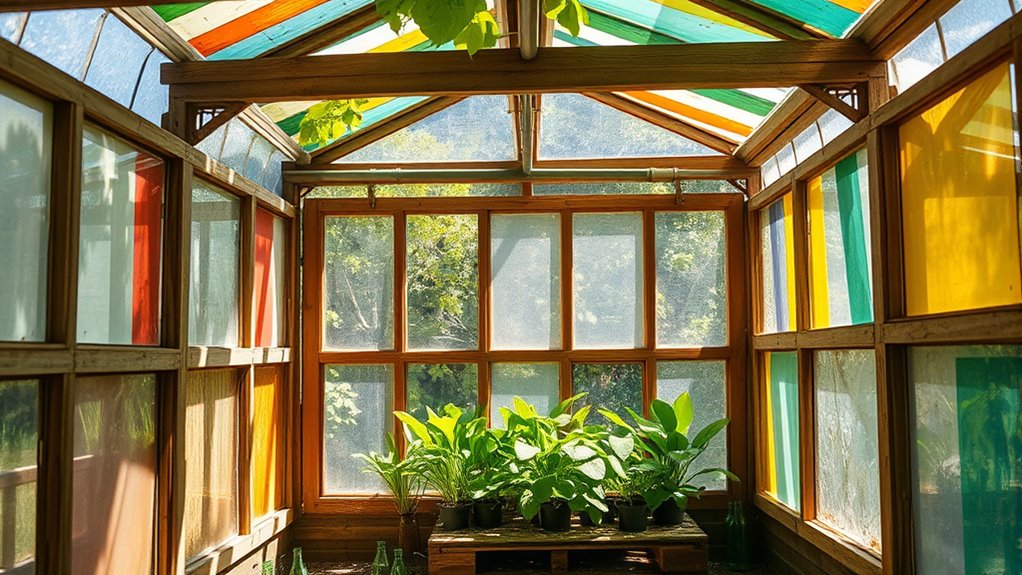
Building a greenhouse with recycled materials is an eco-friendly way to reduce waste and lower costs. However, before you start, you should consider some recycling challenges that come with repurposing materials. Not all items are suitable for greenhouse construction, and sorting through what can be reused might require extra effort. Some materials may need thorough cleaning or treatment to guarantee they are safe and functional. Additionally, you’ll want to evaluate whether the recycled materials can withstand the environmental conditions of your greenhouse. This leads to an important factor: material durability. Not all recycled materials are created equal in terms of strength and longevity, so choosing items that can endure exposure to moisture, temperature fluctuations, and sunlight is essential.
Building with recycled materials requires careful selection and durability considerations for long-lasting, eco-friendly greenhouses.
For example, recycled plastics, such as salvaged polycarbonate sheets or PET bottles, can be excellent for glazing or creating irrigation systems. They’re lightweight, relatively durable, and easy to clean, but you need to verify their stability over time. Some plastics may degrade or become brittle after prolonged exposure to UV rays, which could compromise your greenhouse’s integrity. As such, selecting recycled plastics with UV-resistant coatings or treatments can extend their lifespan. Wooden pallets and reclaimed lumber are popular choices for framing or shelving, but you must check for rot, insect damage, or splintering. Treated wood might be more durable and resistant to moisture, but it’s essential to guarantee that any chemicals used aren’t harmful to plants or soil.
Another consideration is the structural strength of recycled materials. For instance, old window frames or doors can serve as walls or vents, but their age and condition determine if they’ll hold up under environmental stress. Reinforcing weaker sections or combining them with sturdier recycled components can help improve overall durability. Metal scraps, when properly cleaned and treated, can be used for framing or support structures, offering excellent strength and resistance to weathering. Always inspect recycled materials thoroughly for cracks, rust, or weaknesses that could jeopardize your greenhouse’s stability. Moreover, understanding the properties of recycled materials can help you select the best options for your specific climate and structural needs.
Ultimately, building with recycled materials demands a thoughtful approach to address recycling challenges and guarantee material durability. You’ll need to balance sustainability with practicality, selecting items that are both eco-friendly and capable of withstanding the conditions inside and outside your greenhouse. Doing so not only helps protect the environment by reducing waste but also creates a sturdy, functional space for your plants to thrive. With careful planning and inspection, you can successfully harness recycled materials to build a greenhouse that’s both cost-effective and environmentally responsible.
Frequently Asked Questions
How Long Do Recycled Materials Typically Last in Greenhouse Construction?
Recycled materials’ durability varies depending on the type and exposure, but generally, they last 10 to 30 years in greenhouse construction. You’ll find that materials like recycled plastics or metals tend to be more durable, requiring less maintenance. However, some recycled wood or composite materials might need regular upkeep to prevent rot or degradation. Keep in mind, proper treatment and maintenance can extend their lifespan and keep your greenhouse in great shape longer.
Are There Any Safety Concerns With Using Recycled Materials?
You should always conduct a hazard assessment before using recycled materials in your greenhouse to identify potential safety concerns. Make certain the materials have proper certification, confirming they’re safe and free from harmful chemicals or contaminants. By doing this, you minimize risks like mold, pests, or toxic substances that could affect plant health or your safety. Always prioritize verified, certified recycled materials for a safer, eco-friendly greenhouse building process.
What Are the Best Sources for High-Quality Recycled Building Materials?
Think of finding recycled building materials like treasure hunting—you want the best, most durable pieces. You should check out local recycling centers, which often have high-quality, vetted materials. Online marketplaces also offer a wide selection, sometimes at better prices. Always inspect the items carefully and ask about their history to guarantee safety and quality. These sources help you build sustainably without sacrificing strength or safety.
How Do Recycled Materials Impact Greenhouse Insulation and Energy Efficiency?
Recycled materials can positively impact your greenhouse’s insulation benefits and energy savings. By using items like reclaimed wood, recycled plastic, or crushed concrete, you create natural barriers that help retain heat and reduce drafts. These materials often have good thermal properties, leading to lower energy costs for heating and cooling. Ultimately, incorporating recycled materials enhances your greenhouse’s efficiency while supporting sustainability efforts.
Can Recycled Materials Be Customized to Fit Specific Greenhouse Designs?
Imagine your greenhouse as a tailored suit—recycling customization and material flexibility let you cut and sew recycled materials to perfectly fit your design. You can shape and adapt these eco-friendly resources to match unique structures, ensuring a seamless blend of sustainability and style. Recycling customization empowers you to craft a greenhouse that’s both functional and eco-conscious, transforming recycled materials into bespoke elements that suit your vision precisely.
Conclusion
By choosing recycled materials for your greenhouse, you’re not only saving money but also helping the environment. Did you know that using reclaimed wood and recycled plastics can reduce greenhouse gas emissions by up to 70% compared to new materials? Every small step counts, and your eco-friendly approach can inspire others to follow suit. So go ahead—build green, save resources, and enjoy nurturing your plants in a sustainable way. Your efforts truly make a difference!


